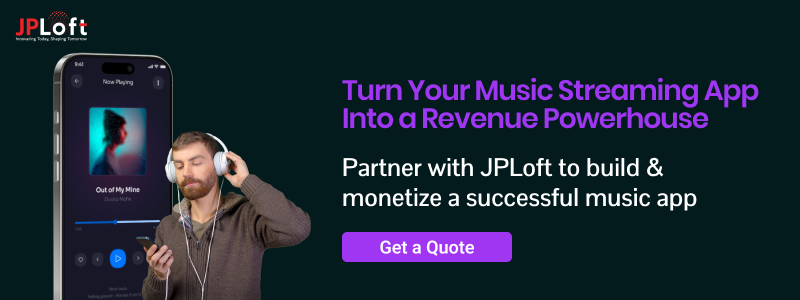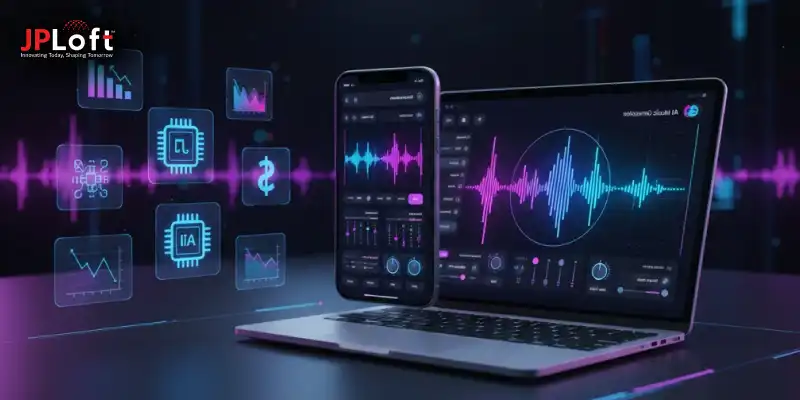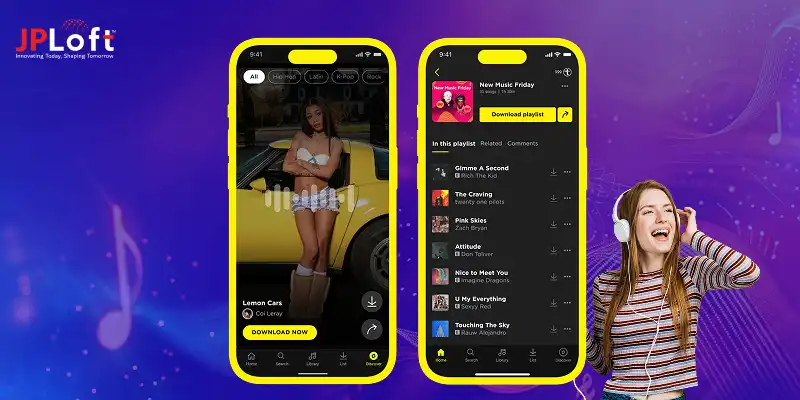Imagine your favorite song playing anytime, anywhere, with just a tap.
Music streaming apps have made this convenience a part of our daily lives. From global giants like Spotify and Apple Music to niche players catering to specific genres, the music streaming industry is on a crescendo of growth.
But have you ever thought about how these apps generate revenue?
With millions of users grooving to their favorite beats, monetizing a music streaming app is more complex than just playing ads between tracks.
The competition is fierce, and picking the right strategy can make or break your app’s financial harmony.
Whether you're planning to launch your app or improve your existing revenue model, understanding music streaming app monetization strategies is the key.
This blog explores the potential of the music streaming industry, dives into effective music streaming app monetization methods, and helps you choose the perfect strategy tailored to your app's audience and goals.
Let’s get started on unlocking the secrets to transforming your app into a profitable platform while keeping users tuned in.
After all, finding the right rhythm in monetization is as important as delivering a great listening experience.
Shall we?
Monetization Potential of Music Streaming Industry: Statistics
The music streaming industry has struck a chord with billions of users worldwide.
This digital symphony isn’t just a source of entertainment-it’s a booming business opportunity.
Let’s explore the numbers that showcase its immense monetization potential. And also become the reason why people develop music streaming app:
-
Global Revenue Growth: The global music streaming market was valued at over $30 billion in 2023 and is projected to reach $50 billion by 2030, growing at a compound annual growth rate (CAGR) of approximately 7%.
-
Subscription Power: Paid subscriptions are driving revenue, with over 500 million active subscribers globally in 2024. This number is expected to rise as premium plans offer ad-free and high-quality music streaming.
-
Ad-Supported Revenue: Ads in free-tier services contribute significantly, generating an estimated $5 billion in 2023, showcasing the potential of hybrid monetization models.
-
Regional Dominance: The U.S. leads the market, followed by Europe and Asia-Pacific, making these regions prime targets for app launches.
-
User Engagement: On average, users spend over 18 hours per week streaming music, highlighting the opportunity to engage them with personalized content and monetization techniques.
With such promising figures, the music streaming industry is a treasure trove for entrepreneurs.
The next step? Tuning into the right monetization strategies for your app.
Comprehensive Music Streaming App Monetization Methods
Here are 11 comprehensive monetization strategies for music streaming apps.
Each method is explained in detail, including how it works, potential earnings, examples, pros, and cons.
1. Subscription-Based Model
The subscription-based model is the most reliable revenue stream for music streaming apps. It offers users enhanced features such as ad-free listening, offline playback, and superior audio quality in exchange for a monthly or annual fee.
-
How It Works:
Subscription tiers include basic, family, and premium plans. Premium plans may also include exclusive content, early releases, or high-definition sound quality, providing value for committed listeners.
-
Monetization Potential:
Spotify reported generating $12 billion in 2023, with 90% of its revenue coming from premium users.
ARPU (Average Revenue Per User) typically ranges from $5-$15/month depending on the pricing strategy.
-
Examples: Spotify Premium, Apple Music, Amazon Music.
|
Pros |
Cons |
|
Ensures consistent monthly revenue |
Challenging to convert free-tier users into subscribers |
|
Enhances user loyalty through exclusive perks |
Requires ongoing investment in premium features |
|
Scalable and adaptable to user preferences |
Higher competition in subscription pricing |
2. Ad-Supported Model
This model focuses on generating revenue from non-paying users by displaying targeted ads during their listening experience. Ads can include audio, video, or static banners.
-
How It Works:
Ads are delivered in intervals during music playback or placed as banners on the app interface. Platforms earn revenue through Cost Per Impression (CPM) or Cost Per Click (CPC) advertising metrics.
-
Monetization Potential:
Platforms like Pandora generated $1.7 billion in 2023 from ad revenue.
CPM rates range between $10-$30, depending on user demographics and engagement.
-
Examples: Pandora (free tier), YouTube Music (free tier).
|
Pros |
Cons |
|
Attracts a larger user base due to no subscription fees |
Frequent ads can frustrate users |
|
Provides an entry point for new users |
Lower revenue compared to subscription models |
|
Helps monetize casual listeners |
Relies heavily on advertiser partnerships |
3. Freemium Model
The freemium model is a hybrid approach where users can enjoy basic services for free while being encouraged to upgrade to premium plans for advanced features.
-
How It Works:
Free-tier users can stream music with limitations such as ads and restricted skips. Premium subscribers unlock ad-free listening, downloads, and exclusive content.
-
Monetization Potential:
Spotify’s freemium model helped it achieve over 500 million active users, converting 30% into paying subscribers.
ARPU ranges from $3-$10/month, depending on conversion rates.
-
Examples: Spotify, Deezer.
|
Pros |
Cons |
|
Balances user acquisition and revenue generation |
Requires careful calibration between free and premium offerings |
|
Provides a smooth transition to paid plans |
Free-tier users consume significant server resources |
4. In-App Purchases (IAPs)
IAPs enable users to buy additional features or content within the app, offering another revenue stream.
-
How It Works:
Users can purchase virtual items, such as exclusive playlists, custom themes, vocal effects, or even artist merchandise, directly within the app.
-
Monetization Potential:
Karaoke apps like Smule generate 5-10% of their revenue through in-app purchases.
Add-on pricing ranges from $0.99 to $19.99, depending on the offering.
-
Examples: Smule, SoundCloud.
|
Pros |
Cons |
|
Encourages user engagement through customization |
Requires a broad inventory of appealing content |
|
Generates additional revenue beyond subscriptions |
Over-reliance on IAPs may frustrate users |
5. Partnerships and Sponsorships
Collaborating with brands or artists for sponsored content and campaigns can generate substantial revenue while enhancing user experience.
-
How It Works:
Brands sponsor playlists, host exclusive events, or promote their products via in-app placements. Sponsorships may also involve co-branded campaigns.
-
Monetization Potential:
Sponsored playlists can generate $5,000-$50,000 per campaign, depending on reach and audience size.
Long-term sponsorship deals with big brands can bring in millions.
-
Examples: Spotify’s partnerships with Coca-Cola and Nike.
|
Pros |
Cons |
|
Boosts credibility and app visibility |
Requires a substantial user base |
|
Diversifies revenue streams |
Risk of alienating users with excessive sponsorships |
6. Pay-Per-Download Model
A classic revenue model where users pay a one-time fee to download and own individual tracks or albums.
-
How It Works:
Tracks or albums are priced for one-time purchase, with users gaining offline access. This model appeals to listeners who prefer ownership over subscriptions.
-
Monetization Potential:
Platforms like iTunes dominated this space, generating billions annually before streaming took over.
Pricing ranges from $0.99-$9.99 per download.
-
Examples: iTunes, Amazon Music.
|
Pros |
Cons |
|
Generates immediate revenue |
Declining demand due to the popularity of streaming |
|
Appeals to users who prefer one-time payments |
May not support recurring revenue growth |
7. Exclusive Content
Providing exclusive or early-release content is a powerful way to attract niche audiences and differentiate your app.
-
How It Works:
Collaborate with artists to release exclusive tracks, albums, or live sessions that are unavailable on competitor platforms.
-
Monetization Potential:
Exclusive deals can increase subscriptions by 15-20%.
High-profile partnerships can drive millions in additional revenue.
-
Examples: Tidal’s exclusive deals with Jay-Z and Beyoncé.
|
Pros |
Cons |
|
Attracts dedicated fans and niche audiences |
High costs for securing exclusive rights |
|
Builds brand differentiation |
Limited appeal without consistent exclusives |
8. Affiliate Marketing
Earn commissions by promoting third-party products, such as concert tickets, music equipment, or online courses.
-
How It Works:
Partner with relevant companies and embed affiliate links or ads within your app. Earn a percentage of sales generated through those links.
-
Monetization Potential:
Commission rates range from 5-20% per sale, depending on the partnership.
Integration with ticketing platforms like Eventbrite or Amazon Associates can boost revenues.
-
Examples: Spotify’s concert ticket promotions.
|
Pros |
Cons |
|
Requires minimal investment |
Revenue depends heavily on traffic and conversion rates |
|
Builds useful partnerships within the industry |
May feel intrusive if overdone |
9. Data Monetization
Leverage anonymized user data to provide valuable insights to advertisers and music producers.
-
How It Works:
Analyze user preferences, listening habits, and demographic data, and sell insights to interested parties, such as advertisers or record labels.
-
Monetization Potential:
Platforms like Spotify earn millions annually by providing anonymized data for ad targeting.
Helps advertisers achieve higher ROI through personalized campaigns.
|
Pros |
Cons |
|
Unlocks additional revenue streams |
Requires strict adherence to privacy laws |
|
Valuable insights improve advertising ROI |
May lead to user mistrust without transparency |
10. Ticket Sales Integration
Sell tickets for live concerts, virtual performances, or exclusive artist events directly through the app.
-
How It Works:
Integrate ticket sales within the app, earning commissions for every purchase made through the platform.
-
Monetization Potential:
Concert tickets range from $50-$200, with apps earning 5-10% commission per sale.
Virtual event ticketing is also a growing revenue opportunity.
-
Examples: Spotify Live Events, StubHub integrations.
|
Pros |
Cons |
|
Enhances user engagement |
Seasonal demand affects consistency |
|
Strengthens ties between fans and artists |
Integration costs can be high |
11. Merchandise Sales
Sell branded or artist-specific merchandise such as T-shirts, posters, or vinyl records directly within the app.
-
How It Works:
Partner with artists to create exclusive merchandise, showcasing it within your app for users to purchase.
-
Monetization Potential:
Merchandise sales contribute an additional 10-15% of app revenue annually.
Items typically priced from $15-$100 attract dedicated fans.
-
Examples: Bandcamp’s artist merchandise sales.
|
Pros |
Cons |
|
Complements music streaming experience |
Inventory management can be complex |
|
Builds artist loyalty |
Limited appeal to casual listeners |
How to Choose the Right Monetization Strategy for Your Music Streaming App
Selecting the right monetization strategy is crucial for your app’s success.
While every method has its merits, the ideal strategy depends on your app’s target audience, goals, and competitive positioning.
Here’s a step-by-step guide to help you decide:
► Understand Your Target Audience
Your users’ preferences play a pivotal role in determining the best monetization model.
Key Considerations:
-
Are your users price-sensitive or willing to pay for premium features?
-
Do they prefer ad-supported content or ad-free experiences?
-
Is your audience niche (e.g., audiophiles) or mass-market?
For example, audiophiles may prefer subscription models with high-quality audio, while casual listeners might be more receptive to ad-supported options.
► Analyze Market Trends and Competitors
Study successful apps in the music streaming industry to understand what’s working and why.
Key Questions:
-
What monetization strategies are your competitors using?
-
Are there any gaps in their offerings that you can fill?
-
Which strategies have the highest user satisfaction?
For instance, if most competitors rely on subscriptions, adding exclusive content or in-app purchases could give you a competitive edge.
► Assess Your App’s Features and Value Proposition
Your monetization model should align with the value your app delivers.
-
Scenario 1: If your app offers high-quality, niche content, a subscription model may be the most effective.
-
Scenario 2: If your app relies on a large user base, ad-supported and freemium models can maximize reach and revenue.
► Consider the Development Stage of Your App
Your app’s growth phase can influence the choice of strategy.
-
For New Apps: Start with freemium or ad-supported models to attract a larger audience.
-
For Established Apps: Introduce premium tiers, in-app purchases, or exclusive content for monetization.
► Evaluate Monetization Potential
Estimate the revenue potential of each strategy based on your projected user base and engagement levels.
Questions to Ask:
-
How much revenue can this model generate per user?
-
What are the operational costs associated with this model?
-
Is the strategy scalable with growth?
For example, subscription models offer predictable revenue streams, while ad-supported models depend heavily on user engagement and ad partnerships.
► Test Multiple Strategies
Don’t settle for a single approach-experiment with a combination of models to find the best fit.
Examples of Hybrid Models:
-
Freemium with in-app purchases.
-
Subscription tiers combined with sponsored playlists.
-
Ad-supported free tier alongside a premium subscription option.
► Focus on User Experience
User satisfaction is key to retaining and monetizing your audience.
-
Avoid overwhelming users with excessive ads or aggressive upselling.
-
Ensure premium features genuinely enhance the user experience.
For instance, offering an ad-free premium plan with offline downloads can encourage free-tier users to upgrade.
► Leverage Analytics and Feedback
Use app analytics to track user behavior and monetization performance. Combine this data with direct user feedback to fine-tune your strategy.
Metrics to Monitor:
-
Conversion rates (free to premium).
-
Ad engagement and click-through rates.
-
Retention rates for subscription users.
By carefully assessing your app’s audience, features, and market position, you can craft a monetization strategy that not only generates revenue but also fosters user loyalty.
Why JPLoft is Your Ideal Partner for Music Streaming App Development
Looking for a partner to turn your music streaming app idea into a reality? JPLoft as a leading music streaming app development company, is here to help.
With a proven track record in crafting innovative music streaming solutions, we blend cutting-edge technology with user-focused designs to create apps that strike the perfect chord with your audience.
At JPLoft, we understand that every app is unique.
Whether you want to integrate advanced monetization models, ensure seamless streaming quality, or provide your users with exclusive features, we’ve got you covered.
Our team of experts excels in building scalable and feature-rich platforms tailored to your business goals.
Let us help you create a music streaming app that resonates with your users and drives sustainable revenue.
Conclusion
The music streaming industry is booming, offering endless opportunities for app creators to generate revenue while delivering exceptional user experiences.
By understanding various music streaming app monetization strategies like subscriptions, ads, in-app purchases, and exclusive content, you can craft a model that aligns with your audience’s preferences and your business goals.
The key to success lies in balancing revenue generation with user satisfaction.
Experiment with different strategies, leverage data analytics, and prioritize a seamless experience to keep your users engaged and loyal.
Remember, the right mix of monetization methods can transform your app into a profitable and beloved platform.
FAQs
The best strategy depends on your app’s audience and goals. Subscription-based models are ideal for premium content, while ad-supported and freemium models work well for reaching a broad audience. Combining multiple strategies often yields the best results.
Earnings vary widely based on user base size, engagement levels, and monetization methods. For instance, subscription-based apps like Spotify generate billions annually, while ad-supported models earn millions depending on ad impressions and partnerships.
Yes, many successful apps use hybrid models. For example, offering a freemium tier with ads and a premium subscription for ad-free access allows you to cater to different user preferences.
Focus on providing value. Avoid excessive ads, offer meaningful premium features, and maintain transparency in pricing. Balancing user experience with revenue goals is crucial.
JPLoft specializes in building scalable, feature-rich apps tailored to your business needs. We integrate advanced monetization models and provide seamless user experiences, ensuring your app stands out in the competitive market.













Share this blog